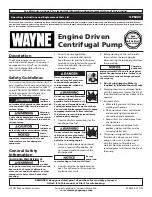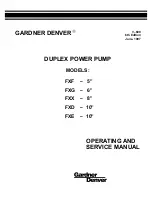
Safety
en
Installation and operating instructions Wilo-Padus UNI
25
Warning – hot surfaces
Warning – high pressure
Warning – suspended loads
Working alone is prohibited! A second person must
be present.
Useful information
2.2
Personnel qualifications
ƒ
Personnel have been instructed on locally applicable regula-
tions governing accident prevention.
ƒ
Personnel have read and understood the installation and oper-
ating instructions.
ƒ
Electrical work: qualified electrician
Person with appropriate technical training, knowledge and ex-
perience who can identify and prevent electrical hazards.
ƒ
Installation/dismantling work: trained sewage technology pro-
fessional
Fixation and pipework in wet well and dry well installation, lift-
ing equipment, basic knowledge of wastewater facilities
ƒ
Maintenance work: trained sewage technology professional
Application/disposal of operating fluids used, basic engineering
knowledge (installation/dismantling)
ƒ
Lifting work: trained specialist for the operation of lifting
devices
Lifting equipment, lifting gear, attachment points
Children and persons with limited abilities
ƒ
Persons under the age of 16: Use of this product is prohibited.
ƒ
Persons under the age of 18: Supervise them during use of the
product (supervisor)!
ƒ
Persons with limited physical, sensory or mental capacities: Use
of this product is prohibited!
2.3
Personal protective equipment
The protective equipment specified is the minimum requirement.
Observe the requirements of the work regulations.
Protective equipment: Transport, installation, removal and
maintenance
ƒ
Safety shoes: Protection class S1 (uvex 1 sport S1)
ƒ
Protective gloves (EN 388): 4X42C (uvex C500)
ƒ
Safety helmet (EN 397): Conforms to standards, protection
against lateral deformation (uvex pheos)
(If lifting equipment is used)
Protective equipment: Cleaning work
ƒ
Protective gloves (EN ISO 374-1): 4X42C + Type A (uvex pro-
tector chemical NK2725B)
ƒ
Safety goggles (EN 166): (uvex skyguard NT)
–
Labelling frame: W 166 34 F CE
–
Labelling disc: 0-0.0* W1 FKN CE
* Protection level according to EN 170 not relevant for this
work.
ƒ
Breathing protection mask (EN 149): Half mask 3M series 6000
with filter 6055 A2
Article recommendations
The articles mentioned in brackets are recommendations. The art-
icles can be replaced with an identical article according to the
mentioned labellings!
2.4
Electrical work
ƒ
Electrical work must be carried out by a qualified electrician.
ƒ
Disconnect device from the mains and secure it against being
switched on again without authorisation.
ƒ
Observe applicable local regulations when connecting to the
mains power supply.
ƒ
Comply with the requirements of the local energy supply com-
pany.
ƒ
Train personnel on how to make electrical connections.
ƒ
Train personnel on the options for switching off the device.
ƒ
Observe the technical information in these installation and op-
erating instructions as well as on the rating plate.
ƒ
Earth the device.
ƒ
Observe provisions for connection to the electrical switching
system.
ƒ
Comply with the specifications on electro-magnetic compat-
ibility when using electronic start-up controllers (e.g. soft
starter or frequency converter). If required, take special meas-
ures into account (e.g. shielded cables, filters, etc.).
ƒ
Replace defective connection cables. Contact customer ser-
vice.
2.5
Monitoring devices
The following monitoring devices must be provided on-site:
Circuit breaker
The size and switching characteristics of the circuit breakers must
conform to the rated current of the connected product. Observe
local regulations.
Motor protection switch
Make provision for an on-site motor protection switch for devices
without a plug! The minimum requirement is a thermal relay/mo-
tor protection switch with temperature compensation, differential
triggering and anti-reactivation device in accordance with the
local regulations. In case of sensitive mains, make provision for the
installation on-site of other protective equipment (e.g. over-
voltage, undervoltage or phase failure relay, etc.).
Residual-current device (RCD)
ƒ
Install a residual-current device (RCD) in accordance with the
regulations of the local energy supply company.
ƒ
If people can come into contact with the device and conduct-
ive fluids, install a residual-current device (RCD).
















































